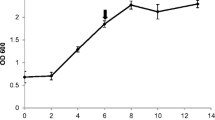Abstract.
The accumulation of anthocyanins in cell cultures of Daucus carota L. and the enzymes involved in their biosynthesis were investigated under growth in the dark, continuous irradiation with UV light, incubation with elicitors from Pythium aphanidermatum, and elicitor treatment of UV-irradiated cells. Upon UV irradiation, anthocyanin accumulation was strongly enhanced, and the enzymes of the phenylpropanoid and flavonoid pathways, including the “late” enzymes cyanidin galac-tosyltransferase, cyanidin galactoside xylosyltransferase, cyanidin triglycoside sinapoyltransferase and sinapic acid glucosyltransferase, all showed transient increases in their activities. The time courses of the enzyme activities exhibited successive maxima with an ordered sequence corresponding to their position in the biosynthetic pathway, suggesting a coordinated induction of the entire set of enzymes. The key enzymes phenylalanine ammonia-lyase and chalcone synthase are regulated on a transcriptional level. Incubation of dark-grown carrot cells with fungal elicitors led to a rapid and transient induction of phenylalanine ammonia-lyase corresponding to the formation of 4-hydroxybenzoic acid, but the amount of anthocyanin did not increase and there was no enhancement of any of the enzyme activities which are part of the anthocyanin pathway, including the enzymes catalyzing glycosylation and acylation reactions. Treatment with UV light and elicitors resulted in a rapid induction of the phenylpropanoid pathway, whereas the inducing effect of UV light on the anthocyanin content, on chalcone synthase and on the enzymes catalyzing the final steps of anthocyanin biosynthesis was suppressed. These results indicate a coordinated regulation of the enzymes involved in anthocyanin biosynthesis, an independent inducibility of the phenylpropanoid pathway, and a hierarchy of the different effectors, as shown by the dominating role of the elicitor-signal over the UV stimulus.
Similar content being viewed by others
Author information
Authors and Affiliations
Additional information
Received: 14 June 1997 / Accepted: 11 September 1997
Rights and permissions
About this article
Cite this article
Gläßgen, W., Rose, A., Madlung, J. et al. Regulation of enzymes involved in anthocyanin biosynthesis in carrot cell cultures in response to treatment with ultraviolet light and fungal elicitors. Planta 204, 490–498 (1998). https://doi.org/10.1007/s004250050283
Issue Date:
DOI: https://doi.org/10.1007/s004250050283



